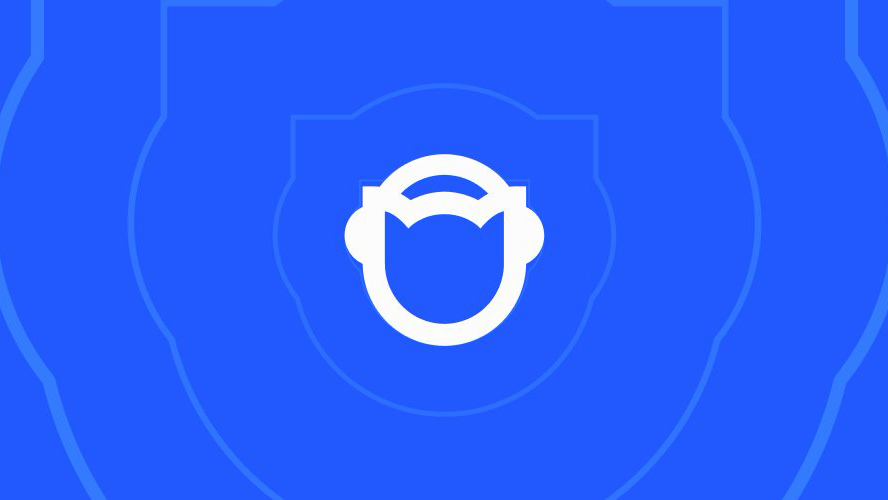What is Napster and how to upload your music free
From popularizing online file sharing, to transforming the music industry, here is everything you as an artist need to know about Napster.
Perhaps one of the most interesting back stories in the music streaming game, Napster has its roots in piracy and changed the shape of the industry to what it is today. Today, although fewer users than the big players, Napster has the features and catalog to keep up with the likes of Spotify and Apple Music. For independent artists and label managers, it’s important to ensure your music is live wherever your audience is. Reach more listeners by uploading to Napster today.
Click below to jump to one of the following:
How to upload to Napster
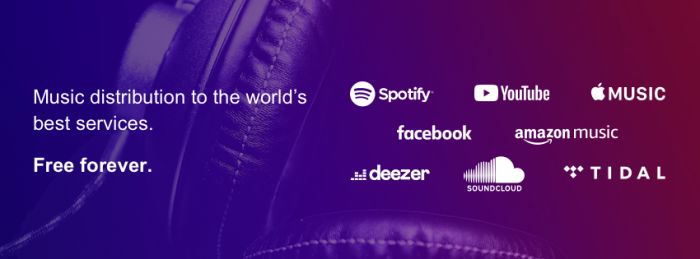
Since 2010, RouteNote has been partnered with Napster. Since then, we have seen the platform shift, grow and continue to support artists around the world. Many other distributors still don’t distribute to Napster, including DistroKid and Amuse.
Getting your music on to Napster and all of the other top stores and streaming services is free and easy when you distribute with RouteNote!
- Sign up to RouteNote.com
- Head to Distribution – Create New Release
- Fill out all of the required metadata, then upload your music and artwork
- In the Manage Stores page, tick Napster and any other stores you wish to distribute to
- Pick between Free or Premium Distribution
RouteNote Free has no upfront fees or recurring subscription cost. Artists keep 85% of the revenue. With RouteNote Premium, you keep 100% of the revenue generated. Premium has a small upfront fee and $9.99 annual cost. Labels and artists with an established audience should check out our All Access tier.
Unlike other distributors, features and stores remain the same regardless of the tier you choose. Whether distributing with our Free or Premium model, RouteNote artists always retain 100% of the rights to their music. You are free to switch any release to any tier and any time, or you can edit or remove a release entirely. It’s always your choice.
Once you’ve finalized your release, it will be sent to our moderation team. Each release is checked by a human for formatting and copyright errors. They aim to get to your release within 72 hours of it being sent in, however times can extend during busy periods.
After approval, your release will be promptly sent to Napster, who usually gets music live within 7 days. If after 14 days you still can’t see your music on Napster, drop us a message with your release UPC.
Statistics and earnings are reported from most stores 45 days after the close of each month. This means, if your music is streamed in January, you will see the statistics and earnings appear on your RouteNote account from the 15th of March. However for Napster, this is extended to 75 days after the close of each month. Meaning this data and money will appear in the following month’s (April in this example) report.
Napster’s technology powers various other services. When you distribute to Napster, your music will also be sent to the following partners:
- Mobile/Telco Operators
- SFR
- Vivo
- Telefonica
- Drillisch
- Terra
- Huawei
- Retail & E-Commerce
- Rakuten
- Aldi Life Music
- Hofer Life Music
- RecoChoku (powers Tower Records)
- Auto
- Radio
- Audacy
Statistics for these stores will be included under Napster’s earnings.
What is Napster?
Napster was founded by Shawn Fanning and Sean Parker, two individuals deeply immersed in the world of software and technology. Fanning, a programming prodigy, began coding at a young age, while Parker displayed an early talent for recognizing and investing in emerging technologies. Together, they launched Napster, born out of a mutual admiration for music and a disruptive vision for its distribution.
Fanning and Parker aimed to democratize access to music by leveraging the internet to share audio files easily and freely, challenging the traditional music industry model. Their innovative approach not only made music more accessible but also laid the groundwork for the modern digital music landscape, illustrating the enduring impact of their vision on global music distribution.
Napster was introduced in June 1999 by Shawn Fanning and was functional until July 2001. Shawn Fanning was nicknamed “Napster” due to his “nappy-textured” hair, which subsequently became the name of the service.
How did Napster start?

In a time of CDs, cassette tapes and vinyl, just as the internet’s popularity was booming, Napster launched the first popular (thanks to its user-friendly interface) peer-to-peer file sharing application in 1999, with an emphasis on MP3 digital audio files.
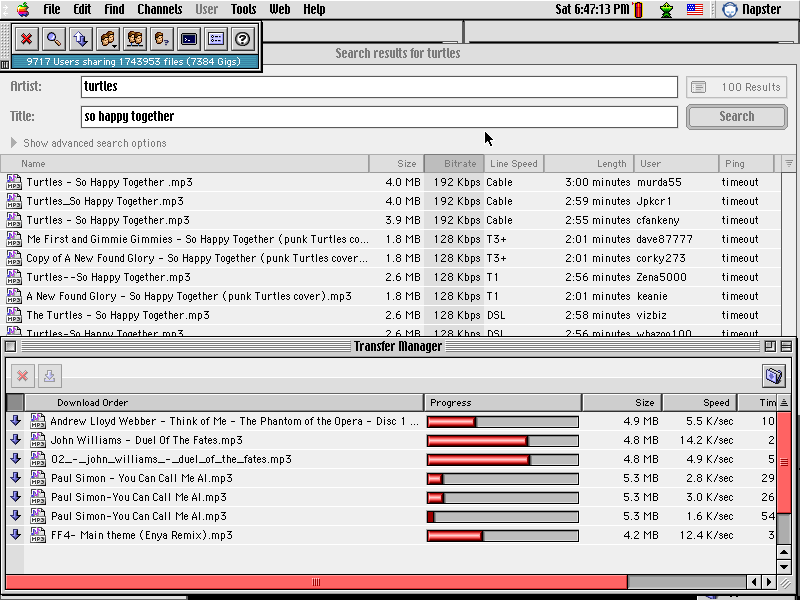
Regardless of its legality, within months, Napster was a hit! Peaking at around 80 million registered users, high-speed networks in college dormitories became overloaded, with some system administrators claiming as much as 61% of external network traffic consisting of MP3 file transfers.
While its popularity was in part due to providing free access to music for the first time, it was also one of the simplest ways to access music overall. Long before music streaming, with Spotify’s launch in 2008, and even before the launch of the iTunes Store in 2003, Napster gave millions of people the ability to get music without leaving the house, for the first time.
It goes without saying, the music industry wasn’t happy with their loss in music sales. Napster soon ran into legal difficulties over copyright infringement. Lawsuits arose from record companies and high profile artists such as Metallica, Dr. Dre and Madonna. This ‘free advertising’ did nothing to slow Napster’s success. In fact, against their best wishes, attention from big names only increased interest in the platform and brought in more traffic over time.
That being said, not all artists were against Napster. Some artists, especially those not signed to major labels and therefore without traditional marketing tools, saw Napster as a great promotional platform. Many suggest Radiohead’s Kid A album scored number one on Billboard, thanks in part to early excitement, driven by Napster.
Eventually, Napster was shut down by court order and ceased operations in 2001, with the company filing for bankruptcy a year later.
Love it or hate, whether you’re an artist or consumer, Napster undeniably changed the course of the music industry, kickstarting music delivery on the internet. Napster is somewhat responsible for digital online stores like the iTunes Store and music streaming services like Spotify. In fact, Apple even called out Napster and Rhapsody during the launch of the iTunes Store.
Against all odds, this wouldn’t be the death of Napster though. Roxio acquired their assets and Napster re-emerged as an online music store in 2003, commonly known as Napster 2.0. Come 2008, Best Buy purchased the service, before 2011, where Rhapsody acquired it and merged it with its own music streaming service.
In 2013, Rhapsody broadened the reach of its Napster-branded service by launching it in 14 new countries, thereby making it accessible to millions more music fans around the globe.
In 2016, Rhapsody made a strategic decision to rebrand all of its music streaming services internationally under the well-known Napster brand. This move was aimed at strengthening Napster’s visibility and accessibility as a leading platform for music-on-demand. It also aimed to enhance Napster’s role as a favored integration partner for other platforms, such as iHeartRadio.
In 2020, the company MelodyVR, which promotes concerts in virtual reality, purchased the Napster platform. Just two years after acquiring it, MelodyVR sold Napster to an investment group led by Hivemind and the cryptocurrency protocol Algorand.

The basic features of Napster
The Napster mobile app has four tabs in the navigation bar at the bottom of the screen.
Home is where to go for a selection of recommended music, tailored to your tastes. Napster serves up recently played music, playlists, new releases, live performances, music videos, and releases from the artists and genres you’ve shown interest in.

In addition to its audio offerings, Napster also enriches its users’ experience by providing a wide selection of music videos. This allows users to engage with music not only through listening but also visually. The platform features an extensive variety of music videos spanning numerous genres including pop, rock, country, and classical, catering to diverse musical tastes. These videos are presented in high definition to enhance the quality of the viewer’s experience, making it more immersive and enjoyable.
The Watch tab brings up just video content from Napster, including new music videos, popular music videos, music videos under specific genres, and additional content like live performances, documentaries and interviews.

Got something in particular you want to listen to? Head to Search, where you can use the search bar at the top of the screen to find the exact artist, song or video you’re after. Use this tab also to browse generic content. You’ll find all moods and genres, as well as popular tracks, albums, artists and music videos.
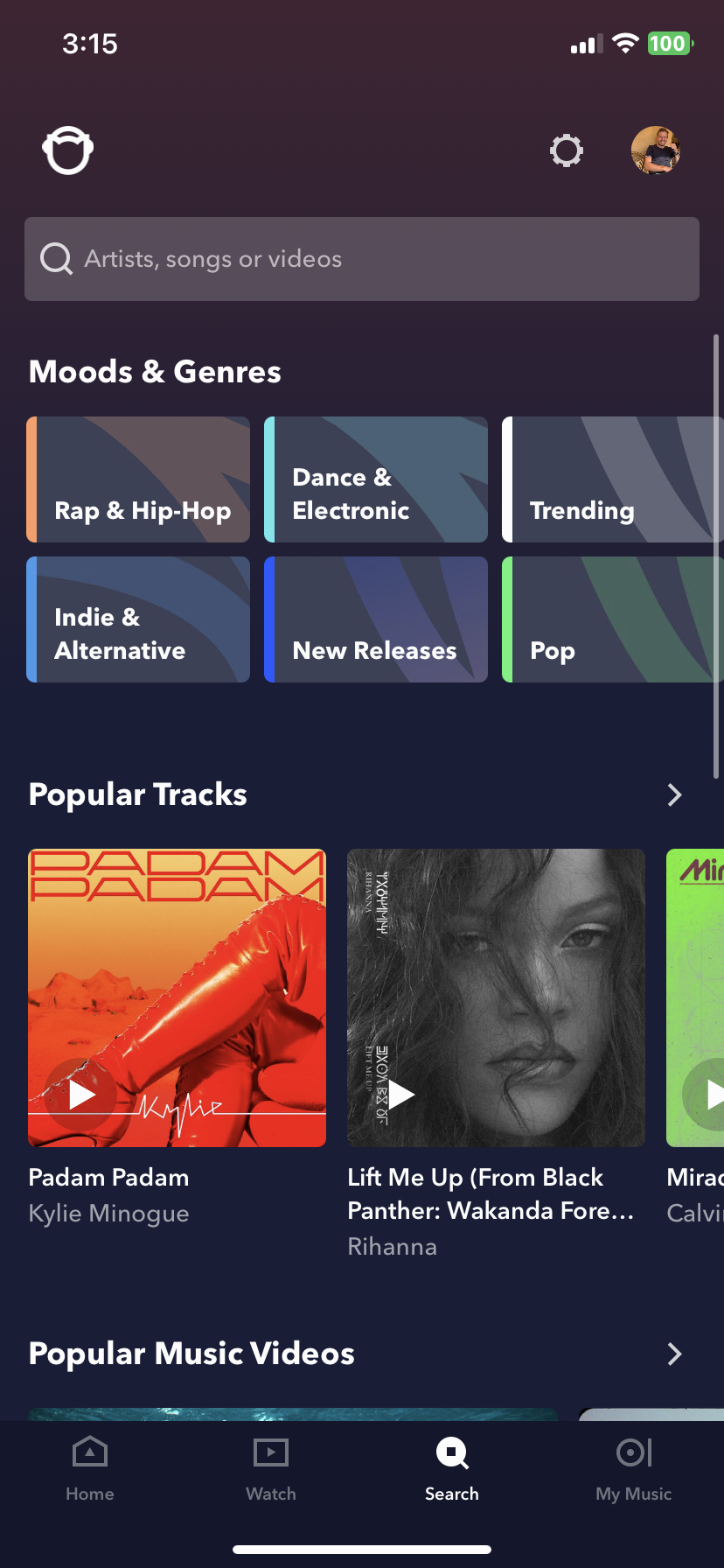
The final tab is My Music. Here you can find all of the music and videos you’ve saved over time. This includes the playlists you’ve created and followed, as well as recently played music, favorites and downloaded tracks, albums, artists, videos and radio stations. There’s also ‘My Top Plays’, which breaks down your most-played artists, albums and tracks, filtered by week, month, year or all time.

Click on the profile icon in the top right corner to edit your user profile. Here you can customize your name, username and profile image, plus find friends.
Use the cog icon at the top of the screen to access the settings. You can access and edit account information, notifications, audio settings, and toggle offline music.
Napster provides a feature called ‘Offline Listening’ which allows users to download their preferred songs, albums, or playlists onto their devices. This ensures that they can enjoy their music without needing an internet connection, making it perfect for scenarios where internet service is unreliable or to save on data usage. Whether users are flying, commuting through areas with poor reception, or just looking to avoid using mobile data, this feature makes it possible to keep their music accessible at all times.
Napster provides premium members with high-quality audio, offering a bitrate of up to 320kbps, which ensures a clear and immersive listening experience. The platform also includes tracks in FLAC format, providing CD-quality Lossless audio to enhance the music experience further. Napster’s commitment to superior sound is evident across its entire music library, aiming to deliver an exceptional audio experience to its users.
From Audio Settings – Audio quality, you can choose between Efficient (AAC 64 kbps), Normal (AAC 192 kbps), High (AAC 320 kbps) and Lossless (44.1 kHz/16 bit), whether playing over WiFi, Cellular or Downloads.
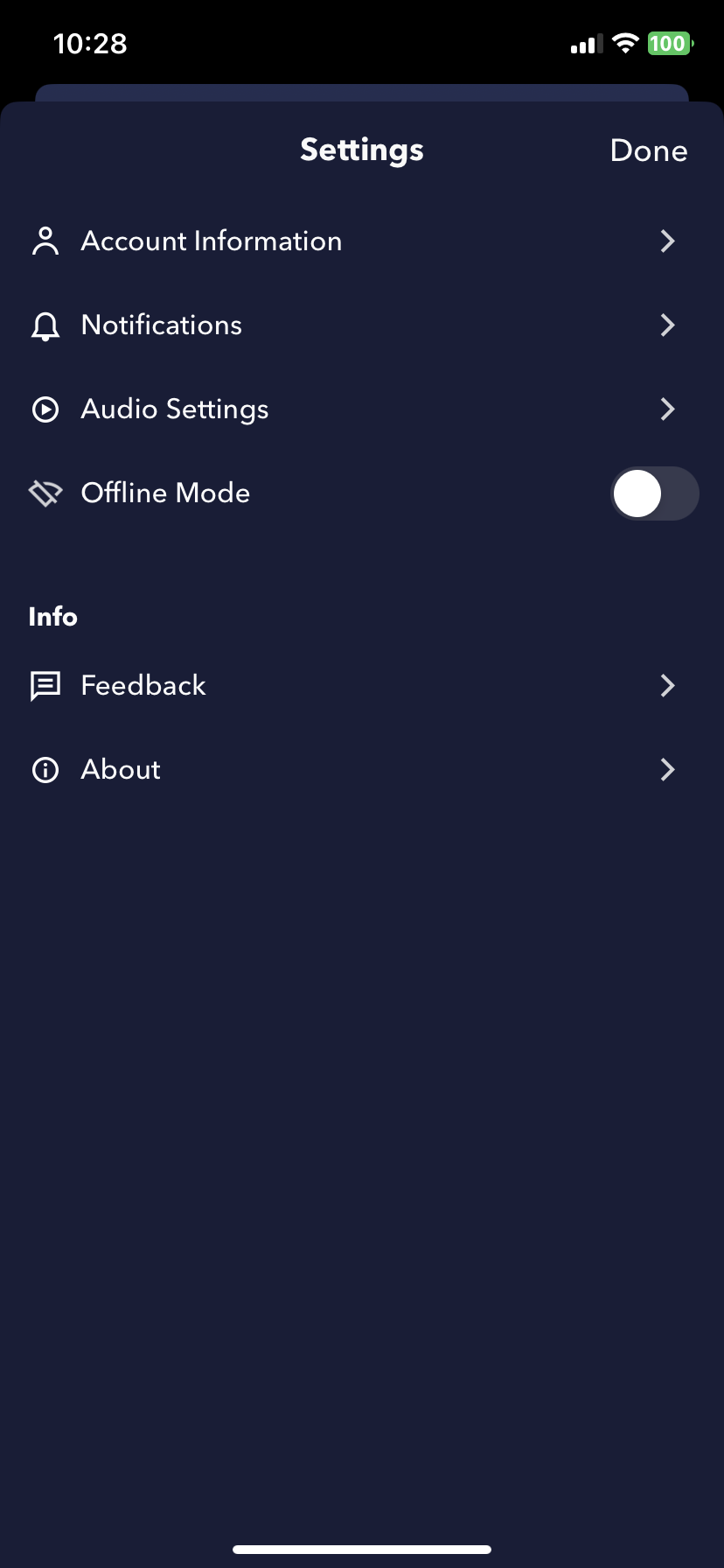
How many tracks are on Napster?
Napster’s homepage advertises an impressive 110+ million tracks. This is higher than all other streaming services, including leading stores like Spotify and Apple Music. Music on Napster comes from major labels, independent labels and distributors, like us! In fact as of 2019, indie artists on the platform make up a third of Napster’s most streamed artists.
Users will also find hundreds of thousands of official music videos, mixes made for you across genres and moods, as well as exclusive and curated playlists such as Discover and New Music Weekly.
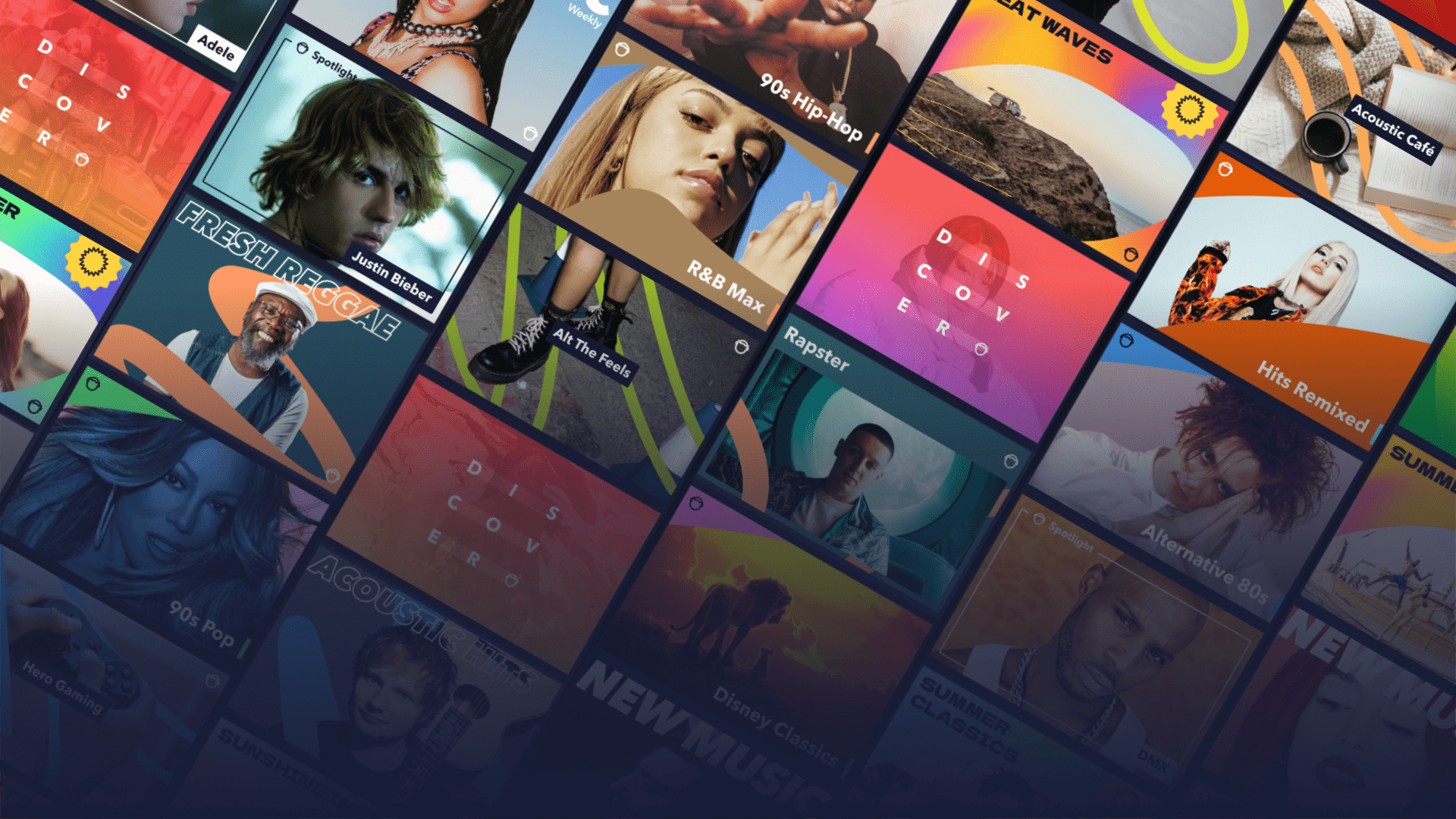
How much does Napster cost?
Napster provides two primary subscription options. The Individual plan is priced at £10.99 each month and includes benefits such as uninterrupted access to Napster’s full music library, the ability to transfer libraries, availability of music videos, and Lossless audio quality where possible. There’s also a promotional offer that includes two free months when you pay annually.
For those looking to accommodate multiple users under one subscription, the Family plan is available at £14.99 per month and supports up to six individual accounts, with each enjoying the same perks as the Individual plan.
Prospective users can start with a 30-day free trial to test all the features of the service before committing to a paid subscription.
Napster is a subscription-only streaming service. There is no ad-supported free tier. You must be a paying subscriber to access Napster. All subscriptions come with 30 days free for new users. The following US prices are based on subscribing outside of app stores, which can add additional fees.
Subscribing to Napster’s Individual plan provides listeners with ad-free listening on all devices. Select tracks are available in lossless audio quality, up to 44.1 kHz/16 bit. Users can download tracks for offline playback.
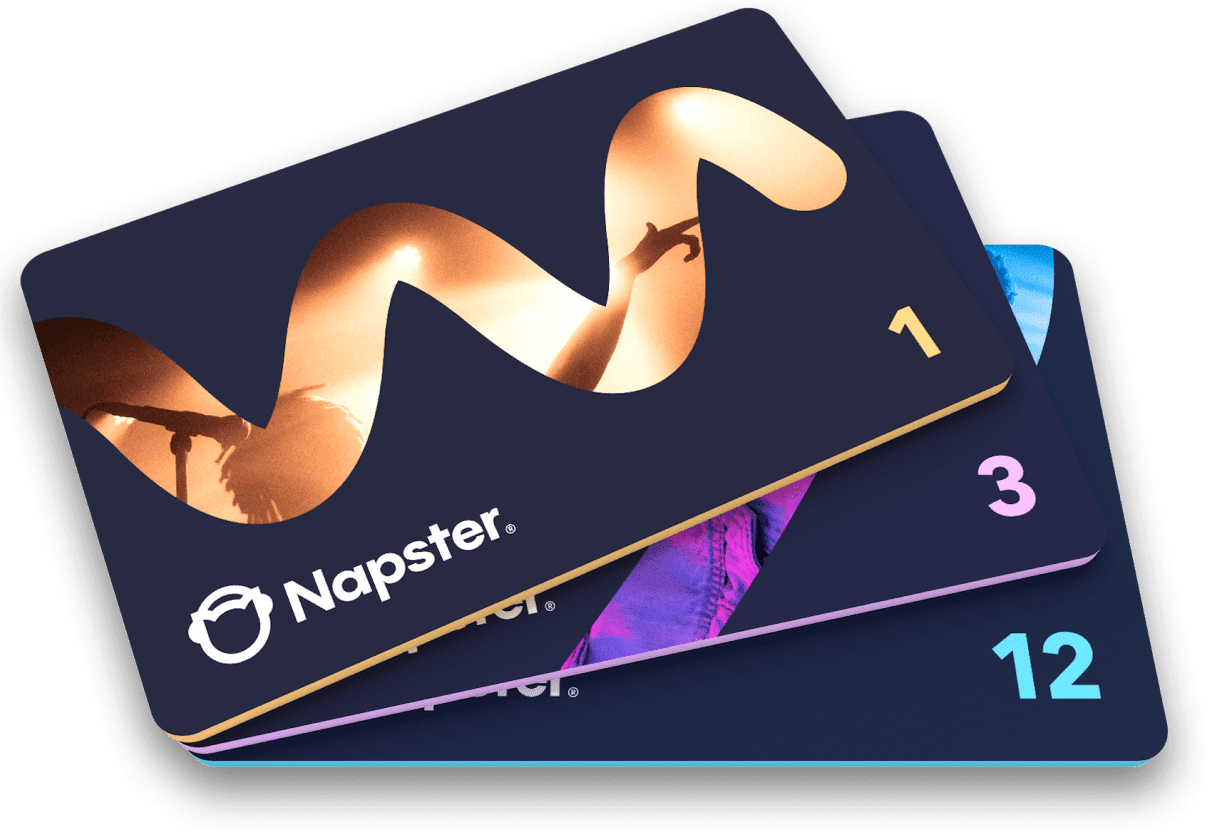
All Napster tiers compared
- Napster Individual
- $10.99/month
- $99.99/year
- Napster Family – six profiles
- $14.99/month
- $149.99/year
How do I log in to Napster?
To set up a Napster account, start by navigating to the “Plans” section on their website. Here, you can choose the subscription option that best suits your needs, which will initialize the account creation process.
To log in to Napster, you have a couple of options depending on your device. If you’re on a desktop computer or laptop, open your web browser and navigate to the official Napster website, where you can find the login page. Enter your username and password in the appropriate fields to access your account.
Alternatively, if you prefer to use a mobile device, download the Napster app from your device’s app store. Once installed, open the app, and you will be prompted to enter your login credentials. Follow the on-screen instructions to sign in and start streaming your music.
The different ways you can stream Napster
Napster allows users to access and enjoy music through various platforms and devices, catering to different preferences and situations:
Mobile Application
The Napster mobile app is accessible on both iOS and Android devices. It features an intuitive and minimalistic design that enhances user interaction and music listening experience. Users can manage and play their music library easily and also connect to various smart devices, such as smartwatches and home assistants, for a hands-free operation.
Web Player and Desktop Application
For those who prefer using a personal computer, Napster provides two options. The web player can be accessed directly through any web browser, perfect for quick access with no download required. For a more robust application, the desktop app is available for both Windows and Mac systems, which can be downloaded from Napster’s official site.
Television and Gaming Consoles
Napster extends its reach to your living room through its TV app, compatible with multiple home entertainment systems like Samsung and LG Smart TVs, Amazon FireTV, Chromecast, Steam Deck, and game consoles including the Xbox Series X|S. This setup is ideal for those who enjoy experiencing music through their home theater systems.
Smart Speaker
Integration with Sonos smart speakers allows users to stream music seamlessly throughout their homes. This feature empowers users to control and play music through voice commands or the Sonos app, facilitating an uninterrupted and high-quality music experience across different rooms. This setup is particularly beneficial for those looking to maintain a continuous play without boundaries, and for sharing music preferences seamlessly with family and friends throughout their living space.
Overall, Napster provides a versatile range of options that cater to the diverse needs of its users, ensuring a seamless music experience across different devices and environments.
Napster is available in 33 countries, including:
- Andorra
- Argentina
- Österreich
- Brasil
- Canada
- Chile
- Colombia
- Costa Rica
- Danmark
- Ecuador
- El Salvador
- Suomi
- France
- Deutschland
- Ελλάδα
- Guatemala
- Ireland
- Italia
- Luxembourg
- México
- Monaco
- Nederland
- Nicaragua
- Norge
- Panamá
- Perú
- Portugal
- España
- Sverige
- Schweiz
- United Kingdom
- United States
- Uruguay
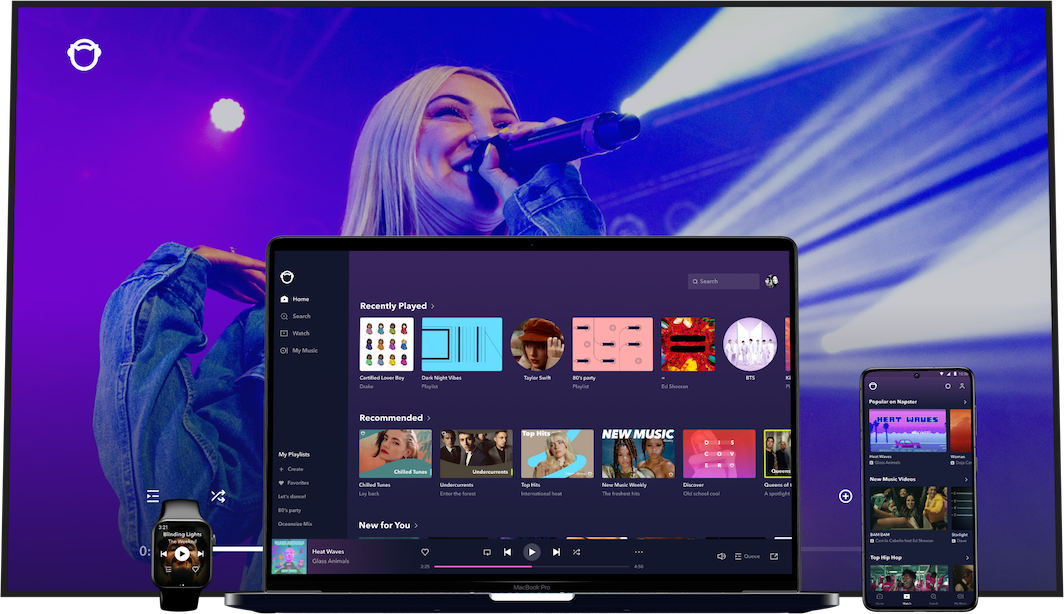
How does Napster compare with the competition?
Although smaller than many music streaming services like Spotify and Apple Music, Napster’s features aren’t to be scoffed at.
- Pros
- Large catalog of music
- Pays artists well
- Reasonable annual and family pricing
- Available on many devices
- Lossless music at no extra cost
- Cons
- No free tier
- No artist portal
- Limited availability – not in Africa, Asia or Oceania
- Lossless tops out at 44.1 kHz/16 bit – no 192 kHz/24 bit option
If you fancy switching or just giving Napster a go, you can transfer your library from another streaming service for free within the 30-day free trial period.
Artists
So you’ve learned all there is to know about Napster and even uploaded your music there… now what? Now it’s time to refresh your artist page on the streaming service. Unfortunately Napster does not have an artist portal like Spotify for Artists to customize your profile, access deeper insights and promotional options. However, as you’re distributing with RouteNote, we’ll go the extra mile for you.
How to customize your Napster artist profile
You can customize your Napster profile image by sending us an image. Napster currently doesn’t offer changes to artists’ bios.
To change your Napster image, drop support@routenote.com an email with your Napster artist name and a 3:2 JPG image. Your image must be at least 1500 x 1000 pixels, with 1920 x 1280 preferred.
How much does Napster pay-per-stream?
As with other streaming services, Napster does not pay artists a flat rate per stream generated. Artists are paid on a pro-rata model. This collects all streaming revenue from subscriptions around the world and pays artists based on the portion of streams they received across the month. As subscription prices vary around the world, this number changes month-by-month.
As a premium-only streaming service, Napster’s estimated pay rate is higher than streaming services that also offer a free tier. Generally ad-supported tiers generate far fewer dollars than premium subscriptions. This, as well as the service not being available in any African or Asian countries, where subscription prices are generally lower than in other continents, leads to particularly high payouts.
From offering music for free in the early 2000s, Napster is now one of the best paying music streaming services in the business. Napster has an estimated average payout of around $0.019 – $0.021 per stream, or around 2 cent. This means an artists needs around 50 streams to earn a dollar and around 50,000 to make their first $1,000. This is a far higher rate than Spotify for example, who are estimated to pay around $0.003 – $0.005 per stream, requiring around 250 streams to earn a dollar.
How to market your music with PUSH.fm
Our friends over at PUSH.fm offer free marketing tools, ideal for independent artists and online creators.
Smart Links
So you’ve got your music on all of the world’s largest streaming services, but how do you accommodate all of your fans with a single link?
Smart Links on PUSH.fm gather all of the links you need on a single page. With a number of templates available, Fan Links are great for musicians looking to share their track that’s available on multiple stores in a single, beautiful landing page.
Fan Links are fully customizable, from the title and description, to the images and URL. You can create an unlimited amount with a free PUSH.fm account.
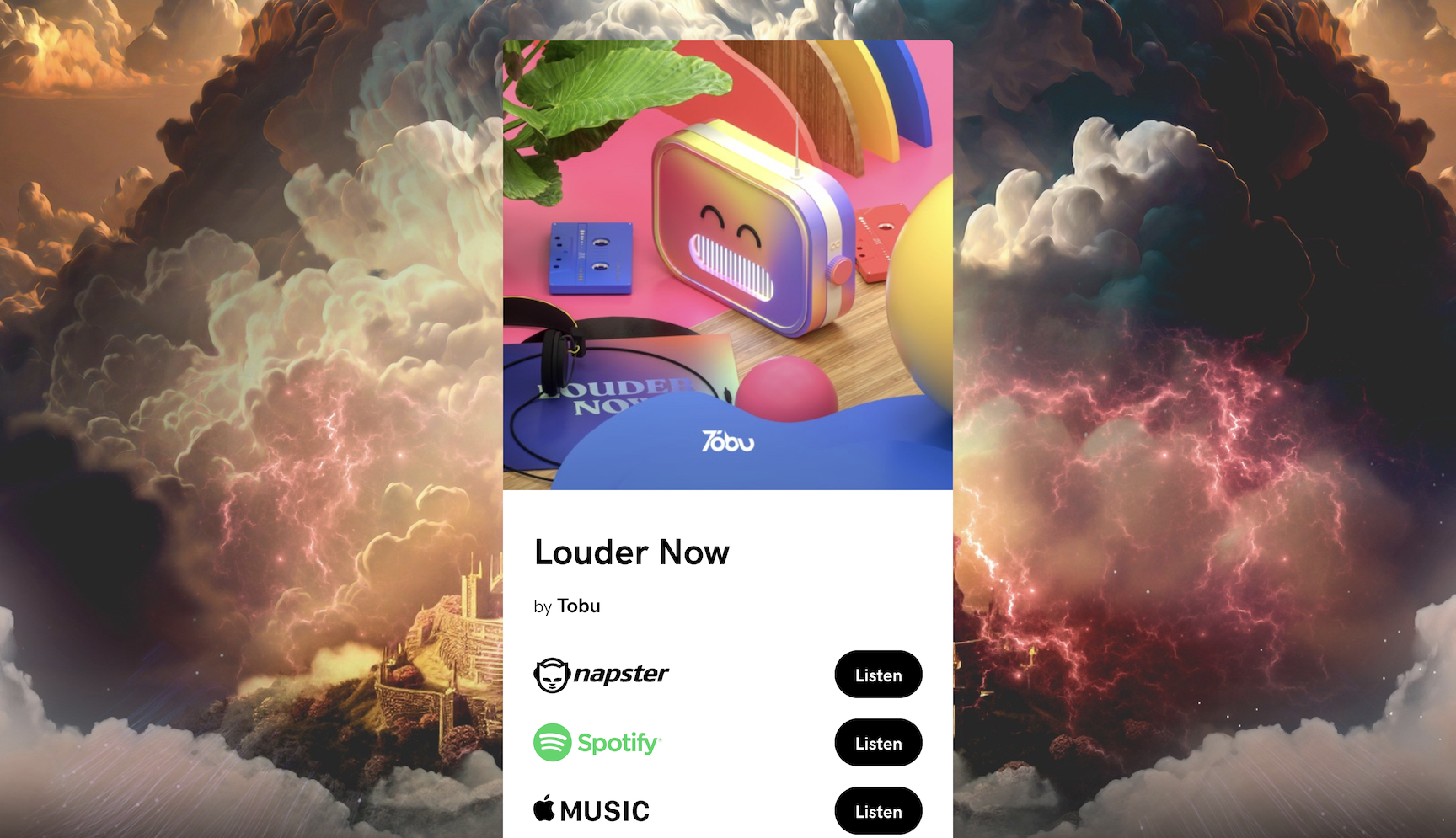
Statistics
So you’ve got your Fan Link up and running. How do you know if anyone’s actually using it or how they’re using it? That’s where performance data comes in.
PUSH.fm provides detailed insights on every one of your links, showing how many visits, conversions, engagement, top services, device types, traffic sources and more, that can be broken down by hour. This information is crucial for independent artists and label managers looking to target future marketing campaigns.
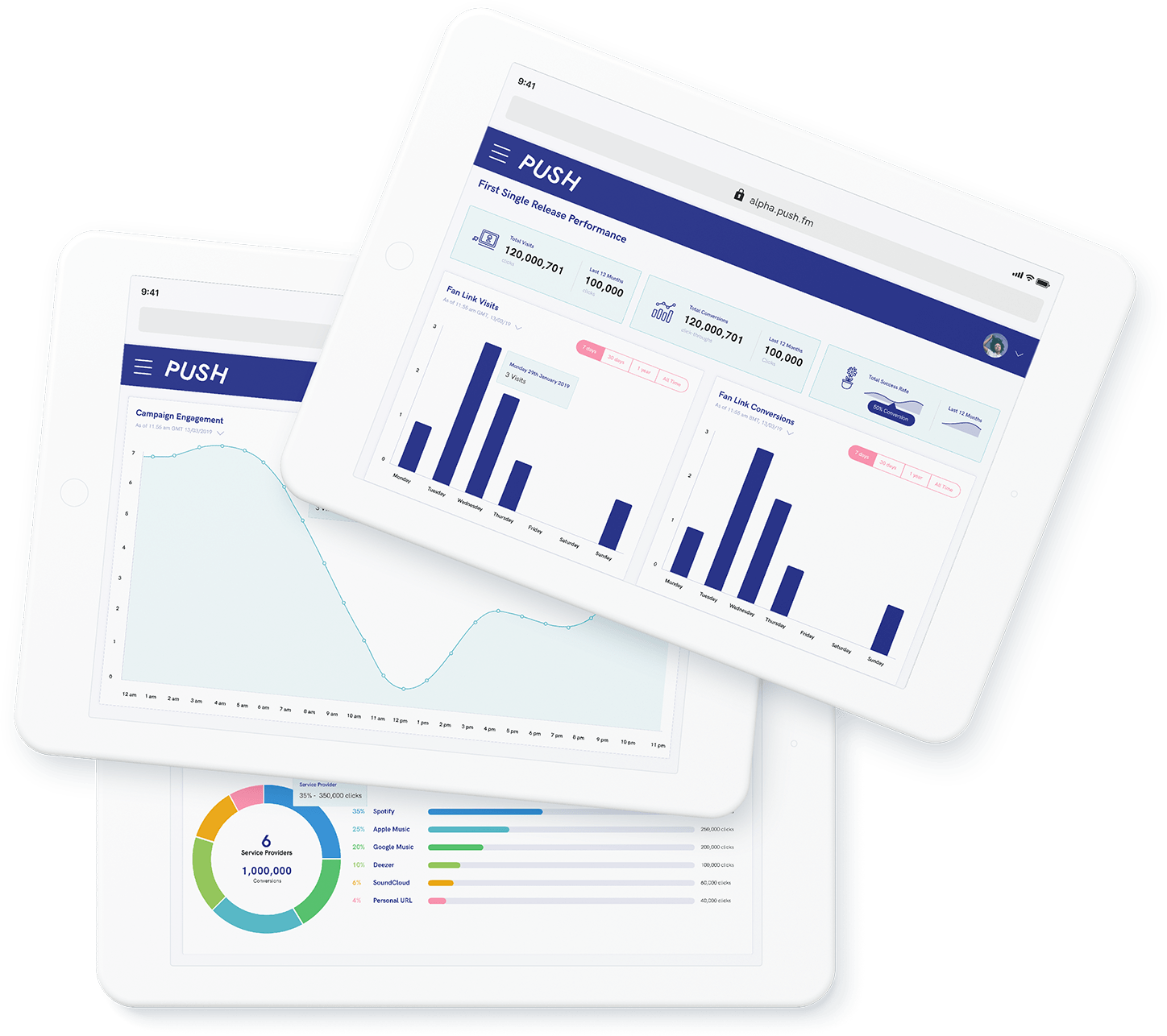
Discover all that PUSH.fm has to offer for you and your music here!
Frequently Asked Questions
Here are answers to the most common questions about Napster, its service, and distributing music to their service as an artist.
How many songs are available in Napster’s music library?
Napster’s music library offers an extensive range of music, featuring more than 110 million songs, encompassing a variety of genres, periods, and artists.
What does Napster Radio offer to users?
Napster Radio provides users with a range of carefully curated radio channels designed to cater to various musical preferences and moods. Additionally, the service is designed to learn and adapt to individual listening habits over time, improving its music recommendations.
How can you transfer your music library to Napster from another streaming service?
Napster offers a streamlined method for users to import music libraries from other streaming services. The platform has implemented an easy-to-use interface that simplifies the migration process, making it accessible even for individuals who may not be technically inclined.
What are Napster’s playlist feature?
Napster‘s playlist feature allows users to dive into playlists crafted to reflect specific moods or musical genres. Napster‘s sophisticated algorithms also play a crucial role by suggesting playlists that not only match but also predict the user’s evolving musical tastes. Additionally, Napster encourages social interaction through collaborative playlist options, enhancing the sense of community and shared musical enjoyment.
What role did Napster play in the legal dispute with Metallica and the music industry?
Napster, initially launched in 1999 as a peer-to-peer (P2P) file-sharing platform, played a central role in a landmark legal dispute with the American heavy metal band Metallica, as well as the broader music industry. This conflict was pivotal in highlighting the challenges and transformative changes in music distribution prompted by digital technologies.
As a platform, Napster enabled users to share digital music files, primarily in MP3 format, making it incredibly easy for millions of users worldwide to access a wide range of music for free. This accessibility and the widespread practice of sharing files without obtaining copyright permissions led to significant contention with established music industry norms and regulations.
The legal battle began when Metallica discovered that a demo of their song, which was not officially released, was circulating on Napster. This incident prompted the band to file a lawsuit against Napster in 2000, claiming that the platform facilitated the unauthorized distribution of their music, thereby infringing on their copyright. Metallica’s lawsuit was emblematic of the broader industry’s clash with digital file-sharing services, as they argued these platforms were severely impacting artists’ potential revenue.
Metallica’s specific allegations included the identification of over 300,000 users who had shared their music on Napster without permission. They demanded that Napster block these users from their platform. This legal battle intensified the debate over digital music rights and sparked a wider discussion about how music should be distributed in the digital age.
The lawsuit resulted in a settlement that led Napster to make significant changes to their operational model, which ultimately paved the way for new, legally compliant music sharing and streaming services. This marked the beginning of a transformation in the industry towards embracing digital distribution models that balance artists’ rights with technological advancements and consumer accessibility.
